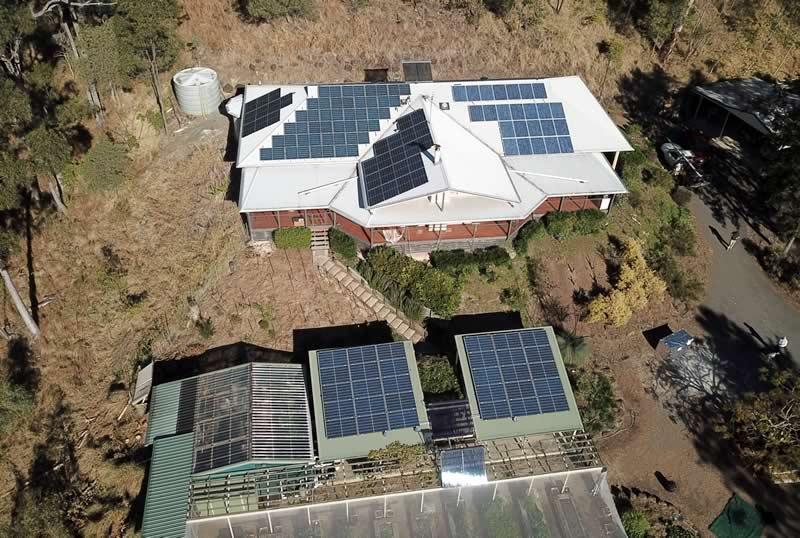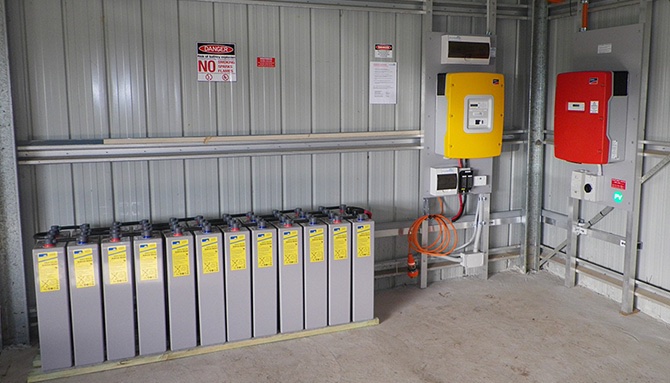Last update March 26th, 2025 at 11:38 pm
Many people across Australia have switched from on-grid power supply to off-grid self-supply in the last few years. By installing a solar panel system on your rooftop, you can get clean power from a renewable energy source, and reduce your carbon footprint significantly.
Solar power is also cost-effective, and you can lower your monthly power costs. With an average payback period of four years (for grid-connected solar systems), you can expect the solar system to pay for itself. You will also get a rebate from the government when installing the system.
So, how to take your home off-grid, and start producing your own electrical power?
In this guide, we will explain everything you need to know.

Should you choose an off-grid or grid-tie solar power system?
First, it is necessary to understand what off-grid actually means. We usually talk about two different types of solar systems: The grid-tie and the off-grid systems. An off-grid solar system means that the power system is completely disconnected from the public power grid.
If you choose an off-grid solar system, you will not have any external power source besides the power produced by your solar panels. Because of this, you might need a large battery bank. That way you can store power that can be used when the amount of sunlight is inefficient.
Systems connected to an energy company network are far more common. These systems will only have power when the solar panel system is actively producing. At night, or during periods with poor sunlight, your house will be powered by the public network.
In periods when your solar power system is producing more power than you need, you can sell the excess power throughout the public energy network. To conclude, you might not want to take your home completely off the grid.
How to take your home off-grid and produce your own power?
In Australia, you can utilise large amounts of sunlight. Because of this, some people choose to take their homes completely out of the public energy network. That way, they never have to worry about expensive power bills.
Here is how you proceed if you want to make your house energy-independent.
Contact a solar power installation company
The first thing you should do is contact a company that can help you with the planning and installation of an independent solar power system. Professionals will then come to your home and find the best solutions for you.
An expert will replace the existing utility power supply in your house with a solar system. The panels will be installed on your rooftop, and the batteries will be placed inside (usually in the basement or a garage).
It is important that the solar panels are placed and angled in a beneficial way. The sunlight should hit the panels as many hours as possible during the day, to produce power effectively. That way you can reduce the risk of running out of power.
Make sure to get enough solar panels
If you are going to take your home off-grid, it is important to install a significant number of solar panels on your roof. In many cases, people cover their entire roof with panels. This is important to generate a sufficient amount of power.
The battery capacity should also be significant. That way you can store big power amounts when the weather is sunny, and use it when it is very cloudy or dark.

What does it cost to make your home energy-independent?
Usually, the average cost of making a house energy independent is significantly higher than getting a grid-tie system. The reason for this is the need for big and expensive batteries. Without the battery, you would not have a sufficient power supply when the sun is not shining.
The average price for taking a medium-sized house off-grid is $15,000 to $25,000. In comparison, a solar system connected to the public energy network would not cost more than $6,200 on average. This is the price you would expect after receiving the government rebate.
So, it might be quite expensive to be completely energy-independent. In many cases, a grid-tie solar system will be a better and more affordable option.
Do you want to learn more about off-grid living?
Taking your home off-grid might be expensive and require some planning, but it can also give you the advantage of being self-supplied when it comes to electrical power.
For some Australians, this solution is the best choice. For others, a tie-grid system works better. Always use CEC-approved installers for any solar connection.
Solaranswers.com is your go-to source for information about solar power systems. If you want to learn more about independent or grid-tie solar panel systems, we have many interesting articles and guides for you. There are specialist quote services that will help you find a suitable and reliable off-grid installer in your area.